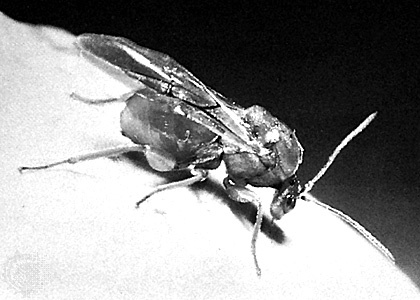gall wasp
insect
 any of a group of wasps in the family Cynipidae (order Hymenoptera) that are notable for their ability to stimulate the growth of galls (gall) (tissue swellings) on plants. Some gall wasp species are gall inquilines, meaning they do not cause the formation of galls but inhabit those made by other insects. The overgrowth of tissue, or gall, presumably is caused by a substance secreted by the immature insect living within it.
any of a group of wasps in the family Cynipidae (order Hymenoptera) that are notable for their ability to stimulate the growth of galls (gall) (tissue swellings) on plants. Some gall wasp species are gall inquilines, meaning they do not cause the formation of galls but inhabit those made by other insects. The overgrowth of tissue, or gall, presumably is caused by a substance secreted by the immature insect living within it.Adults of most of the approximately 600 species of gall wasps that occur in North America are about 6 to 8 mm (about 0.25 to 0.30 inch) long and black. The shiny abdomen is oval, and the thorax has a sculptured appearance.
A given species of gall wasp will cause a characteristic type of gall to form on a certain part of a particular species of plant. Many of these wasps attack oak trees or rose plants.
Male gall wasps are rare, and reproduction usually occurs by parthenogenesis (i.e., larvae develop from unfertilized eggs). The egg passes through the long ovipositor of the female and into the plant tissue. After the egg hatches into a larva, it begins to secrete materials that cause the plant tissues around it to begin to grow faster than normal. The gall increases in size as the larva grows. The larva feeds on the plant tissue within the gall and pupates and transforms into an adult within the gall.
The so-called oak apple, a round, spongy, fruitlike object about 2.5 to 5 cm (1 to 2 inches) in diameter, is caused by the larvae of the gall wasp Biorhiza pallida. About 30 such larvae may develop in a single “apple,” or gall. The marble gall, a green or brown growth about 2.5 cm (1 inch) in diameter, is caused by Andricus kollari. The bedeguar gall (also called moss gall, or robin's pincushion), which may contain about 50 or more larvae, is commonly seen on rose bushes and is caused by the gall wasp Diplolepis rosae.
Most gall wasps are not economically important. However, the galls of some species have been used as a source of tannic acid (tannin) or in the manufacture of inks (ink) or dyes (dye).
- diabetes
- diabetes insipidus
- diabetes mellitus
- diablerie
- Diablo
- Diablo Range
- Dia Center for the Arts
- diaconate
- Diadectes
- Diadochus Of Photice
- diadochy
- diaeresis
- diagenesis
- Diaghilev, Sergey Pavlovich
- diagnosis
- diagnostic imaging
- Diaguita
- dialect
- dialectic
- dialectical materialism
- dialectology
- dialogue
- dialysis
- diamagnetism
- Diamantina